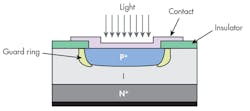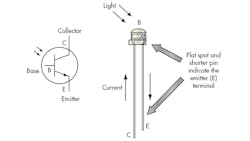Download this article in PDF format.
Ambient light sensors (ALSs) are photodetectors that approximate the human eye’s response to light intensity under a variety of lighting conditions and through different attenuation materials. They’re most commonly found in industrial lighting, consumer electronics, and automotive systems. But they have seen increased usage in LCD-equipped portable products—especially smartphones—because an ALS IC can automatically control the brightness level of the display backlight.
Aside from improving visibility, they help reduce power consumption. LCD backlighting can draw as much as 51% of the power in the input standby mode. One of the main challenges now is selecting an ALS for LCD products with the ability to detect wavelengths visible to the human eye (400-700 nm). There are many types of ALSs; some technologies have been around for decades while others are still maturing.
Types of Ambient Light Sensors
Ambient-light-sensor technologies include photoresistors, photodiodes, phototransistors, and ALS ICs:
Photoresistors: Both a passive electronic component and the simplest optical sensor, the photoresistor has a resistance that varies depending on the light intensity. It also can respond in a way that’s similar to the human eye. In darkness, the resistance is very high (e.g., 1 MΩ) and in the light, the resistance tends to fall down (e.g., 10-20 kΩ at 10 lux). Cadmium-sulfide (CdS) photoresistors (Fig. 1) were very common many years ago, but since 2006, cadmium has been designated as a prohibited RoHS (Restriction of Hazardous Substances) material.
1. A 20-mm CDS photoresistor is made of semiconductor material; its conductance changes with luminance variation. (Courtesy of Senbastana)
Photodiodes: A photodiode is a semiconductor device with a PN or PIN structure that converts light into an electrical current. The PIN structure offers a better area for the collection of light (Fig. 2). Photodiodes have a low output current that requires an external amplification circuit, which commonly operates in reverse bias. Light absorbed in the depletion region or the intrinsic region generates electron-hole pairs, most of which contribute to a photocurrent.
2. Placing the electrical contacts at the side of the device ensures that the maximum amount of light reaches the intrinsic layer. (Courtesy of electronics notes)
A photodiode conducts electric current directly proportional to the amount of light entering the intrinsic region. One of the key characteristics of a photodiode is its response to the wavelength of light, which can vary depending on the material (see the table).
Other types of photodiodes have slightly different modes of operation, such as the avalanche diode and the Schottky photodiode, which promise to adjust better to the needs of a circuit. Photodiodes are used in many applications, such as light meters, flame monitors, bar-code scanners, light pens, and more.
Phototransistors: These semiconductor light sensors are formed from a basic transistor with a much larger base and collector areas that make them more light-sensitive (Fig. 3). A small reverse saturation current, called dark current, flows through the phototransistor even in the absence of light. Its value rises with an increase in the value of temperature, a property identical to that exhibited by ordinary transistors.
3. A commonly used phototransistor symbol has two arrows pointing toward the transistor. (Courtesy of learn.parallax)
Phototransistors have a higher output signal than photodiodes. They’re sensitive to a wide range of wavelengths ranging from ultraviolet (UV) to infrared (IR) through visible radiation. But they can’t handle high voltages if made of silicon. In addition, they have poor high-frequency response due to a large-base collector capacitance. Phototransistors are used in wide range of applications, such as object detection, CD players, infrared receivers, printers and copiers, night-vision systems, etc.
Ambient-light-sensor ICs: Both analog and digital ICs exist—each version is in high demand and still maturing. Such ICs typically perform better than the other ALSs mentioned; for example, the output current is easier to obtain. They also can integrate more functions, which results in less circuitry, thus saving board space and reducing design cost.
The analog current output of an analog ALS is proportional to the incident light level and spectrum sensitivity, similar to the human eye. It can then be converted to a voltage that’s applied to an analog-to-digital converter (ADC) interface on an MCU or directly as an input to an LED driver IC. A digital ALS IC typically has a 16-bit digital I2C output. An integrated ADC converts the output of the photodiode to an I2C signal. ALS ICs are now commonly found in LCD backlighting applications.
Ambient-light-sensor technologies will further evolve due to escalating needs for sensors in portable devices like smartphones. Such devices include more than 10 sensors, and they include ALS ICs. As they evolve, expect to see more ICs integrating ALS with proximity sensors, which is already occurring with a handful of developers.





